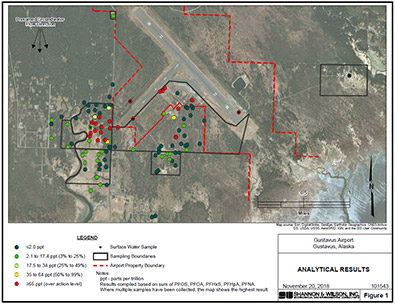Gustavus Airport Firefighting Testing Area Contamination
Page updated 12/18/18 Go back to PFAS Home Page
Community Outreach
- November 20, 2018: Gustavus Water Sampling Results
 (350KB)
(350KB) - October 30, 2018: DOT&PF presentation at community meeting
 (2.6MB)
(2.6MB) - October 22, 2018: PFAS Public Meeting Notice
 (1MB)
(1MB) - October 22, 2018: 3rd Round Gustavus Well Search Map
 (640KB)
(640KB) - September 20, 2018: 2nd Round Gustavus Well Search Map
- August 27, 2018: Presentation by AK Depts of Health & Social Services, and Environmental Conservation
 (1.9 MB)
(1.9 MB) - August 24, 2018: Press release - PFAS Discovered in Groundwater Near Gustavus Airport Firefighting Foam Discharge Areas
 ( 650KB)
( 650KB) - August 23, 2018: PFAS Public Meeting Notice
 ( 640KB)
( 640KB) - August 22, 2018: Letter to Gustavus Residents
 ( 517 KB)
( 517 KB) - August 22, 2018: Gustavus Well Search Map
 (1.2 MB)
(1.2 MB)
Background
DOT&PF was alerted in late July 2018 to concentrations of Per- and Polyfluoroalkyl Substances (PFAS) in the groundwater at Gustavus Airport. The presumed source of PFAS in groundwater at the Gustavus Airport is the Federal Aviation Administration-mandated use of fire-fighting foams at Aircraft Rescue and Firefighting (ARFF) testing areas.
Since then, DOT&PF has worked with an environmental consulting firm, Shannon & Wilson, Inc., and the Alaska Department of Environmental Conservation (DEC) to identify and sample private water wells around the airport. Water sampling was conducted in August, late September / early October, and late October / early November 2018.
Based on those samples, PFAS in 19 wells are reported in concentrations above DEC action levels. Of these, one well serves the Alaska Airlines and Alaska Seaplanes terminals, six wells are used for airplane washing or other non-drinking water uses, and 12 are private or business wells used for drinking water. One of these well results is due to city fire fighting foam use. Concentrations at many private wells and the well which serves the National Park Service water system are below DEC action levels. Many sampled wells show negligible PFAS levels. Based on sample results, the airport-generated plume appears identified within the shallow drinking water zone. See community-wide results.
To date, DOT&PF’s priority in Gustavus has been to identify and provide safe drinking water to those who need it. DOT&PF is providing alternative drinking water to homes with PFAS levels over 65ppt.
Together with DEC and engineering consultants, DOT&PF has begun to assess options for long-term solution to provide clean drinking water. DOT&PF is also beginning site characterization, to determine the specific characteristics of the plume, spread, and influencing hydrology.
In order to track PFAS movement in groundwater, DEC requires continued quarterly monitoring of wells with sample results above 35 parts per trillion (ppt) (in yellow on map) and annual monitoring of wells with sample results above 17.5 ppt (in light green on map).PFAS Fact Sheets
Note: If you have trouble viewing any of the above documents, please contact us for an alternative option.
Contacts
For more information, please contact us.
For questions about testing & study:
Shannon & Wilson, Inc.
Kristen Freiburger, Project Manager
Phone: 907-479-0600
Email: krf@shanwil.com
For regulatory questions:
Alaska Department of Environmental Conservation,
Contaminated Site Program
Danielle Duncan, Environmental Program Specialist
Phone: 907-465-5207
Email: danielle.duncan@alaska.gov
Division of Spill Prevention and Response website:
http://dec.alaska.gov/spar/csp/sites.aspx
For questions about PFAS health effects:
Alaska Department of Health & Social Services
Kristin Bridges, Public Health Scientist
Phone: 907-269-8028
Email: kristin.bridges@alaska.gov
Division of Public Health Website:
www.dhss.alaska.gov/dph/epi/eph/Pages/default.aspx
For claim filing instructions:
Alaska Department of Administration
Division of Risk Management
Scott Jordan, Director
PO Box 110218
Juneau, AK 99811-0218
Phone: 907-465-5723
Fax: 907-465-3690
Email: scott.jordan@alaska.gov
For questions about Gustavus Airport Firefighting Testing Area and all other inquiries:
Alaska Department of Transportation and Public Facilities, Southcoast Region
Aurah Landau, Public Information Officer
Phone: 907-465-4503
Email: airportwater@alaska.gov

